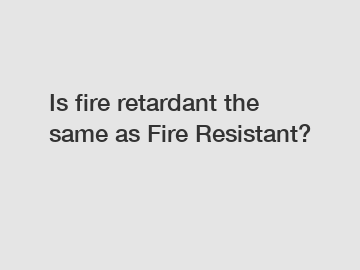Is fire retardant the same as Fire Resistant?
Is fire retardant the same as Fire Resistant?
Fire retardant and fire resistant are terms that are often used interchangeably when it comes to materials that can withstand fire. However, is there a difference between the two? Are they truly the same thing? In this article, we will delve deep into the world of fire safety and explore the nuances between fire retardant and fire resistant materials.
1. Understanding Fire Retardant Materials:

Fire retardant materials are those that are designed to slow down or prevent the spread of fire. These materials are treated with chemicals that can delay or inhibit the ignition or combustion of the material. Fire retardant substances typically release flame-damping gases or form a protective layer when exposed to heat or flames.
2. The Role of Fire Resistant Materials:
Fire resistant materials, on the other hand, are substances that are naturally resistant to catching fire or have been treated to become resistant. They are capable of withstanding fire for a longer time without igniting or melting. Fire-resistant materials are often used to build structures or manufacture items that are intended to provide protection against fire hazards.
3. Different Approaches to Fire Safety:
While both fire retardant and fire resistant materials contribute to fire safety, the key difference lies in their approach. Fire retardant materials act as a form of reactive fire protection. They are mainly used to slow down the spread of fire once it has started. Fire resistant materials, on the other hand, are proactive fire protection tools. They are designed to prevent the fire from starting or spreading altogether.
4. Testing Standards and Certifications:
Fire retardant and fire resistant materials undergo different testing standards to evaluate their effectiveness. Fire retardant materials are often subjected to flammability tests, such as the ASTM E84 or the UL 94 test, which assess their ability to slow down or inhibit the spread of fire. Fire resistant materials, on the other hand, undergo tests like the ASTM E119 or the UL 1709 to determine their ability to withstand fire for a specified period.
5. Application and Limitations:
It is essential to understand the specific applications and limitations of fire retardant and fire resistant materials. Fire retardant materials find extensive use in products like upholstery, curtains, and other textiles where rapid flame spread must be prevented. Fire resistant materials, on the other hand, are commonly used in the construction industry for fire-rated doors, walls, and ceilings, where the primary purpose is to provide structural integrity and prevent fire from breaching compartments.
In conclusion, fire retardant and fire resistant materials may sound similar, but they have distinct differences. Fire retardant materials aim to slow down or inhibit the spread of fire once it has started, while fire resistant materials are designed to resist ignition or withstand fire for a longer period. Understanding these differences is crucial for selecting and using the appropriate materials to enhance fire safety in various scenarios. Whether you require materials that prevent fire from starting or materials that can delay its spread, it is vital to consider the specific requirements and certifications associated with fire safety in order to make the right choice.
Want more information on hi vis material, Flame Resistant Fabric Suppliers, fire retardant stretch fabric? Feel free to contact us.

Comments